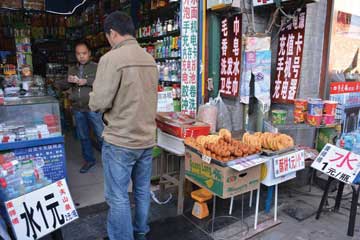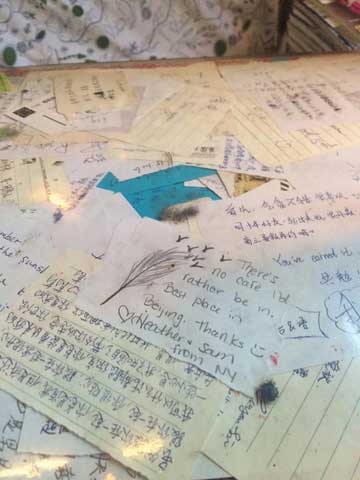AV's literary columnist tells us about her trip to China
by Heather Cook

AV's literary columnist tells us about her trip to China
The Beijing Capital Airport (PEK)—extravagantly silver, modern and polished— was an inaccurate first impression of China. On the crowded Airport Express, the gray haze smothering striking views of China’s countryside, from the Airport into Beijing’s city center, was a disappointing sight. It’s the price they pay for rapid development, unfortunately. I kept thinking my glasses were dirty, frequently wiping them on my sweater—the habit stuck with me for a few days. The smog often gives its people chronic bronchitis, and I quickly understood why the first bulletin board I noticed read, “No spitting everywhere!” beneath Chinese characters. See, though, Americans are lucky in the fact that so many countries, including China, accommodate us by way of translating their subway stops, bulletins, and maps into English. The subway was orderly, straight-forward and easy to follow, making the pushing and shoving more tolerable; but outside of the tube it was alienating, at first.


In the precise moment I stepped off the Beijing subway—6,828 miles from my own country and culture—I was taken aback by the sight of scam artists/beggars singing to me, ambiguous aromas, unfamiliar mannerisms and littered living conditions. I was seized by fear and a desire to return to the comfort of old habits. This is when I had realized what gives value to travel is throwing oneself into a challenging, new environment. Some think of travel as a pleasurable escape; however, for me, pleasure takes away its value just as holding onto old habits do. Figuring out new ways to cope with challenges in a fresh perspective allows one to reassess personal values. Successfully overcoming and growing from culture shock is what gives travel value, right?
I took a deep breath and tried to adapt and blend in as quickly as possible in the cultural hub. This was a difficult task for a wide-eyed redhead, getting pointed at from buses zooming by. By day five, I started waving back. Then we’d all laugh.
The more time I spent in China, the more I began to love it—objectively. Due to government censorship, I was unable to access any sort of social media, YouTube, Google or even my email accounts. This took me completely off the grid, allowing me the space and time I needed to reflect and grow from my struggles. In daylight the city was crowded and loud, a place where people pushed through crowded hútòng: tiny alleyways attaching the city to its ancient past, bustling with street vendors yelling into megaphones, cheap-eats and markets. I learned to be firm in haggling. Anxious by rumors of fly-infested street food, I closely observed the sanitary habits of various food stalls steaming the streets with spice, cooking off the back of cycle rickshaws, before I was brave enough to make my first purchase: lamb kebabs for less than $2. Luckily, the rumors weren’t true, and so I was able to embrace the street food, eating like the locals. Misconceptions could’ve been fatal, because the food was impeccably layered with spice, consistency, and flavor.
Like their food, the city as a whole was also much layered. Off one subway stop rests the Forbidden City, full of historical, colorful buildings and cultural art relics from the Ming and Qing dynasties. Anyone, history buff or not, could easily get lost in the archways and treasure rooms for days. Across the street, I found Tiananmen Square, full of “unmentionable” history and stunning garden sculptures. And only a few stops over, the interesting-to-the-eye, CCTV Headquarters building, made of glass and gray enamel, stood tall in the heart of 798 Art District. Their Bohemian art scene has been on the rise for years, full of contemporary vibes, cat cafes and bookstores. This layering makes Beijing the perfect combination of old and modern. The overpopulated city is also speckled with especially green parks, filled with a large amount of trees (with color-coded plaques representing their ages); housing colorful temples where “park performers” danced and sang well into the evening and, often, locals used the grass as their personal bathroom when heavily-armed police weren’t marching by.
“Bathrooms here are nothing like Western bathrooms,” the Great Wall tour guide, Cindy, told me. At the bottom of the Great Wall, two hours from Beijing, the toilets were holes in the ground between doorless stalls. People pushed and shoved to use them first and there was no toilet paper or hand soap—I quickly learned to carry my own in my backpack. Beyond that, stairs spiraled around the mountains, leading me to numerous watchtowers and enormous views of tiny crowds below, marching up the stairs with the same motivational puffs I had on my way up. That’s when I realized I wasn’t isolated—it turns out we were all after the same challenge: To conquer the steep Great Wall, under a clear blue sky day, in order to get a better view of China.
In fact, the people of China were quite welcoming and patient with me, a stranger spying on their day-to-day lives, when I felt alone. Yes, everyday life in China was very different than the life I live here in America—but it doesn’t make one life better than the other. I met the nicest people in a charming café, further off the beaten path, who light-heartedly played a few rounds of universal charades to help me order my meal and then direct me to the small village I was in search of. Polite locals invited me inside their home, to enjoy fresh fruit and authentic tea off the land, simply because they wanted to swap ideas and experiences. Leaving a lasting mark, China taught me a lot about flexibility and the world I live in. I only hope that I left a small mark somewhere in China, as a thank-you.
blog comments powered by Disqus|
Issue Navigation> Issue Index > v14n44 (Week of Thursday, November 5) > AV's literary columnist tells us about her trip to China This Week's Issue • Artvoice Daily • Artvoice TV • Events Calendar • Classifieds |









 Current Issue
Current Issue